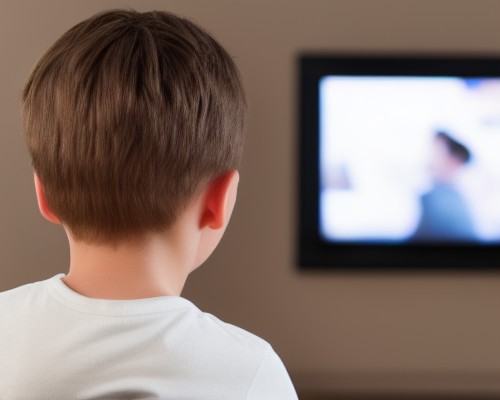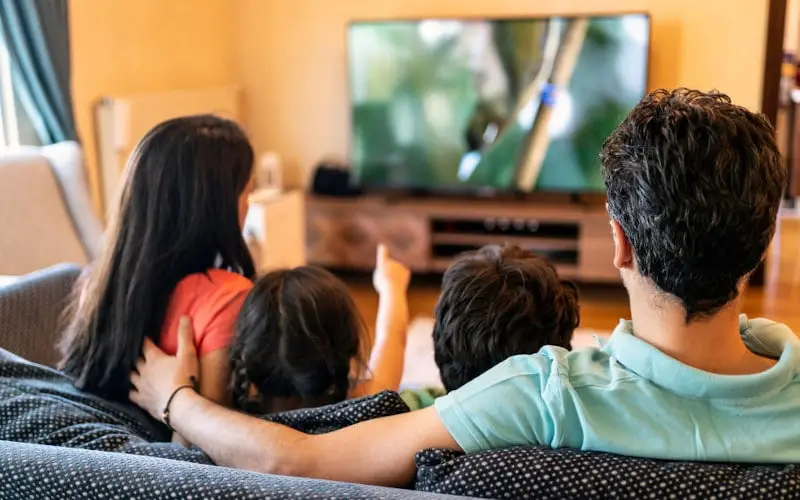Many different factors determine how long your TV will last. How you use it, the environment in which it is used, and the type of TV all play a part in determining how quickly or slowly your television’s parts deteriorate.
Depending on usage and maintenance, a television’s average lifespan generally falls between 4 to 10 years (40,000 – 100,000 hours).
The lifespan of a TV depends on these factors, but there are some general guidelines to follow.
How Long an LCD TV Last?
LCD TVs typically last around 50,000 hours. That’s 17 years of continuous use if you watch for 8 hours a day. However, your TV will likely not last long if used improperly.
TVs are designed to last a long time, but it’s up to you whether or not your TV will have the lifespan it is capable of. If you use your TV incorrectly, such as leaving static images on-screen for extended periods or placing electronics in direct sunlight where they can overheat, this can shorten its lifespan.
LCD TVs can be placed in any environment but should not be exposed to direct sunlight for extended periods. Sunlight can cause the television’s backlighting to fail much more quickly.
So, to ensure you get the most out of your TV, be deliberate about how and where you use it.
How Long a Plasma TV Last?
A plasma TV can last for years when it is properly cared for. However, a plasma television’s lifespan of 60,000 to 100,000 hours may be reduced by the following:
- Storage in direct sunlight
- Placing heavy items on top of your TV
- Operating at high altitudes where the air is thinner and dryer
- Frequent on-off cycling, which reduces the longevity of any TV over time
- The contrast ratio is also important in determining how long your plasma television will last
Plasma TVs with low contrast ratios may have a shorter lifespan than those with higher ones.
If you have a plasma TV, it is best to keep it in a cool, dry place. This will help to prevent the formation of image burn-in on the screen.
How Long Does an LED TV Last?
LED TVs usually have a lifespan of about 100,000 hours. That’s 34 years of continuous use if you watch for 8 hours a day. LED TVs can last for years if they are used properly and the quality of the product is good.
However, like plasma TVs, their life expectancy will likely be reduced by frequent on-off cycling or placing heavy items on top of them, among other things.
However, LED TVs are not affected by sunlight in the same way that plasma and LCD televisions are.
Keeping your TV clean and dust-free can also help extend its lifespan by preventing damage to the internal parts. Don’t expect it to last forever, no matter what type of television you have or how careful you are with it.
Eventually, it will need to be replaced. But if you take good care of your TV and use it sparingly, it can last for many years.

How Long Does an OLED TV Last?
The lifespan of an OLED TV is typically around 30,000 hours. That’s about 10 years of continuous use at 8 hours a day. However, this number can vary depending on how the TV is used and what type of environment it is in.
OLED TVs are very new on the market, so there is not much information about their lifespan. However, they do have some advantages over LED and LCD televisions.
First, OLED screens do not use backlighting like other flat-panel displays. An OLED TV can be thinner than many smartphones. OLED screens are also more energy-efficient than LED/LCDs.
No matter what kind of TV you have, be sure to take care of it. Regularly clean the screen and keep it out of direct sunlight. If you do these things, your TV should last for a while.
How Long Do CRT TVs Last?
CRT TVs usually last around 20,000 to 30,000 hours, or about 10 years if you watch for 8 hours per day.
Cathode-ray tube TVs, or CRT TVs, have been around since the 1920s. They were once the most common type of TV, but they are now becoming less and less popular. CRT TVs use an electron gun to shoot a beam at a phosphor coating on the back of the screen. This beam lights up the pixels on the screen and creates the image you see.
CRT TVs use a lot of electricity, so they are not as energy-efficient as other types of TVs. They also produce a lot of heat, which can shorten the lifespan of the TV. CRT TVs usually last around four to six years if used eight hours a day.
How Long Does a Smart TV Last?
Smart TVs usually last around 8 years if they’re used moderately. If you use your smart TV more often, it might only last 4 years.
It’s important to remember that a TV’s lifespan can also depend on the brand and model. Some TVs are built to last longer than others. So, if you’re looking to buy a new TV, research and find one that will last as long as possible.
How Do You Know When Your TV Is Going Bad?
There are a few telltale signs that your TV is nearing the end of its lifespan. One of the most obvious is a decline in picture quality. If you notice that your once-clear images are starting to look fuzzy or pixelated, it may be time for an upgrade.
Another sign that your TV is going bad is increased screen flickering. A problem with the power supply, the backlight, or the refresh rate can cause this. If you notice that your TV is flickering more frequently, it’s best to consult a professional to diagnose the issue.
Finally, if your television makes odd noises, it’s probably time for a new one. Buzzing, popping, and clicking sounds can indicate problems with the internal components of your TV. If you’re experiencing any of these issues, it’s best to start shopping for a new television.
How Common Is Burn-In On OLED TVs?
While an OLED burn-in is technically possible, it is highly unlikely that you will ever experience it on your OLED TV. This is because burn-in only occurs when the pixels display an image for an extended period at high brightness.
In other words, you would have to use your TV extremely unrealistic for burn-in to become an issue. Even then, most OLED TVs have built-in protections against burn-in, so it’s not something you need to worry about.
So go ahead and enjoy your OLED TV without worrying about burn-in; it’s practically impossible to experience it under normal usage conditions.
Ask the Manufacturer
If you’re unsure how to use your TV properly, ask the manufacturer or consult an expert. Improper use can dramatically reduce the lifespan of your television and may even void the warranty. Taking good care of your TV will help last as long as possible!
Some TVs come with a lifetime guarantee from the manufacturer. However, this is often only valid if the TV is used in a specific way or under specific conditions. Be sure to read the warranty carefully before you purchase a television to make sure you qualify for the lifetime guarantee.
TVs are a big investment, so knowing how long they will last is important. By understanding the factors that affect the lifespan of a TV, you can make an informed decision about which TV is right for your household and how long it should last.
Which Brand TV Lasts The Longest?
With so many TV brands to choose from, it can be challenging to decide which one will provide the best longevity. If you’re looking for a reliable brand that will last through the years, LG, Sony, Samsung, and Panasonic are likely the most reliable.
But if you have a tighter budget, Sharp and Vizio are also great options. While these brands might not offer as much longevity as their more expensive counterparts, they can still offer several years of use if maintained properly.
It’s important to remember that whatever brand is chosen, regular maintenance on your TV can help ensure it lasts for many years.
Conclusion
Now that you know a little bit more about how long TVs last, you can decide when it’s time to buy a new one.






